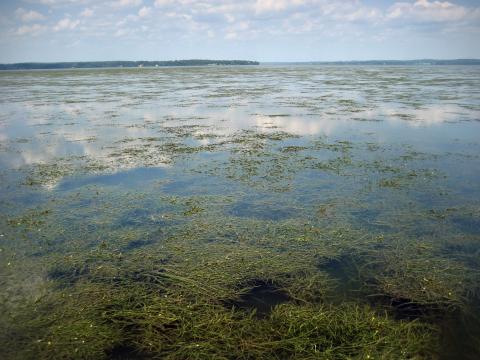CAMBRIDGE, MD (May 1, 2019)—A landmark paper on the comeback of underwater grasses in Chesapeake Bay has received the prestigious Cozzarelli Prize, an award that recognizes outstanding contributions to the scientific disciplines represented by the National Academy of Sciences.
"Long-term nutrient reductions lead to the unprecedented recovery of a temperate coastal region," published in the Proceedings of the National Academy of Sciences, includes University of Maryland Center for Environmental Science authors Bill Dennison, Rebecca Murphy, Jeremy Testa, and alumna Cassie Gurbisz.

The resurgence of underwater grasses in the estuary are the direct result of decades of efforts to reduce nutrient pollution in the Chesapeake Bay.
According to the study, the resurgence of underwater grasses in the estuary are the direct result of decades of efforts to reduce nutrient pollution in the Chesapeake Bay. An analysis of more than 30 years of data showed that sustained management actions over the past two decades have reduced nutrient pollution in the Chesapeake by 23% since 1984 and have led to a resurgence of ecologically and economically important aquatic grasses. Underwater grasses, also known as submerged aquatic vegetation (SAV), have regained 17,000 hectares to achieve the highest cover in almost half a century.
Aquatic grasses are known as a sentinel species, an indicator of broader ecological function or an early warning of ecological impairment. They are important ecologically, providing habitat for baby crabs and other creatures while protecting shorelines and stabilizing sediments so that erosion is minimized. They are also important economically since they are home for commercial species such as blue crab, silver perch, and striped bass.
Researchers from 10 institutions across the country analyzed 30 years of data to predict the impacts of people living near the Bay on submerged aquatic vegetation, an ecologically and economically viable habitat. The study used aerial surveys from 1984 to 2015, monitoring data, historical information on land use and fertilizer application and watershed model estimates for the loads of nutrients and sediments from land runoff and point source such as wastewater treatment plants.
The Editorial Board of the Proceedings of the National Academy of Sciences (PNAS) selected six papers from the more than 3,200 research articles that appeared in the journal last year to receive the prize. Awardees were recognized at an awards ceremony during the NAS Annual Meeting on April 28, 2019, in Washington, D.C.
Related:
